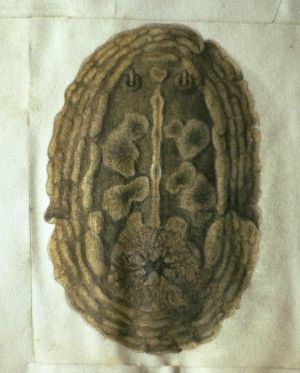
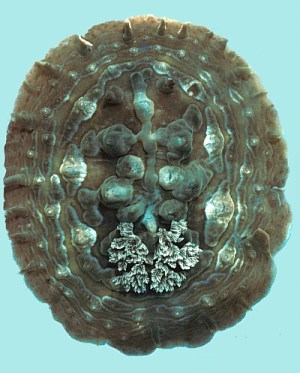
Asteronotus cespitosus
(van Hasselt, 1824)
Order: NUDIBRANCHIA
Suborder: DORIDINA
Superfamily: EUDORIDOIDEA
Family: Dorididae
DISTRIBUTION
Tropical Indo-West Pacific.
PHOTO
UPPER: Photo of Van Hasselt's original painting, 1824, ex Leiden Museum.
LOWER: Viti Levu Bay, Fiji, 105mm long October 1982. Photo: B. Carlson.
Usually coloured with the distnctive colour pattern in the illustrations alongside, but sometimes it is a uniform yellow-brown without the colour pattern. It can grow very large, at least to 25 cm long.
For some reason early naturalists found this animal rather repulsive, giving it a number of names likening it to unattractive body organs (the liver and brain) or descriptive terms denoting its unattractiveness. Kelaart (1858), when describing it from Ceylon as Doris exanthemata stated:
"The whole animal gives one more the idea of a horrid disease than the charms of sea nymph".
Other synonyms are Doris cerebralis Gould, 1852; Doris foetida Pease, 1860 and Doris hepatica Abraham, 1877.
Reference:
• Hasselt, J.C.v. (1824). In: Andre Férussac. Extrait d'une lettre du Dr. J.C. van Hasselt au Prof. van Swinderen sur mollusques de Java (traduit de l'Allgem. konst en letterbode, 1824, nos. 2,3,4) Tjuringe (ile Java) le 25 Mai 1823 (1). Bulletin des Sciences Naturelle et de Geologie, 3: 237-248.
Rudman, W.B., 2001 (April 29) Asteronotus cespitosus (van Hasselt, 1824). [In] Sea Slug Forum. Australian Museum, Sydney. Available from http://www.seaslugforum.net/find/astecesp
Related messages
Asteronotus cespitosus from Singapore
March 22, 2010
From: Ron Yeo
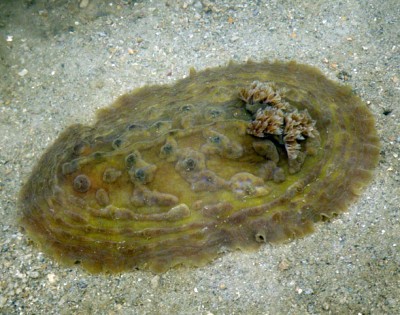
Dear Bill,
I found this huge nudibranch, and initially thought it be be a Dendrodoris carbunculosa. However, it has much simpler tubercles and has several long ridges nearer to the sides of the animal forming broken rings around it. The underside looks very different too. Have you come across something like this before?
Locality: Pulau Semakau, Singapore, Straits of Singapore, 21 March 2010, Intertidal. Length: 20cm. Photographer: Ron Yeo.
Thanks.
regards,
Ron Yeo
ronyeo@gmail.com
Yeo, R.K.H., 2010 (Mar 22) Asteronotus cespitosus from Singapore. [Message in] Sea Slug Forum. Australian Museum, Sydney. Available from http://www.seaslugforum.net/find/23374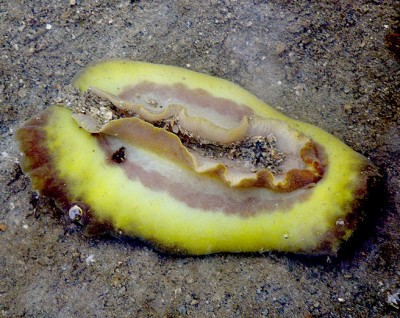
Dear Ron,
This is Asteronotus cespitosus. It can grow quite a bit larger than your animal. I think there is a record on the Forum of a 40 cm long individual.
Best wishes,
Bill Rudman
Asteronotus cespitosus from North Queensland, Australia
April 9, 2007
From: Paul Osmond
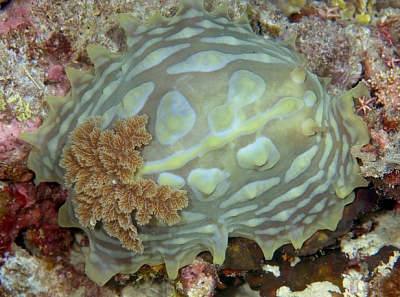
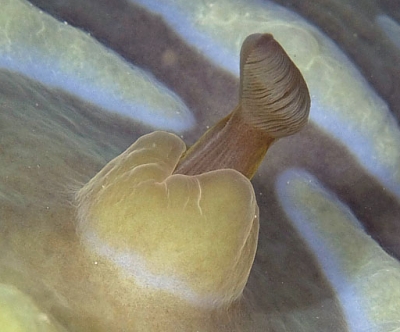
This big nudibranch of about 20 cm was moving across the bottom of a coral reef head at night on a coral reef in the Wheeler Reef system off of Townsville in Queensland, Australia. I believe this is Asteronotus cespitosus.
Locality: Wheeler Reef, Great Barrier Reef, Townsville, 20m, Queensland, Australia, Pacific, 31 December 2006, Coral reef head, sandy bottom. Length: 200mm. Photographer: Paul T. Osmond.
Had the macro lens on, so took a few shots of the individual parts of the animal.
Yours,
Paul
www.deepseaimages.com
marriard@deepseaimages.com
Osmond, P.T., 2007 (Apr 9) Asteronotus cespitosus from North Queensland, Australia. [Message in] Sea Slug Forum. Australian Museum, Sydney. Available from http://www.seaslugforum.net/find/19698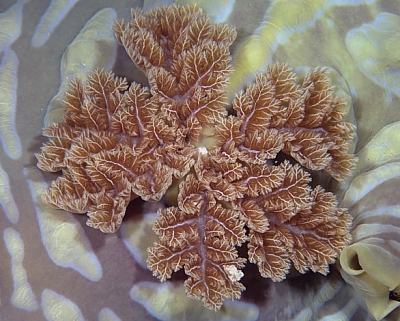
Dear Paul,
Thnaks for these photos. Although it is not as brightly coloured as many nudibranchs, there is beauty in the detail. I don't think it deserves the derogatory words said about it by early naturalists [see Fact Sheet] - it has never reminded me of a 'horrid disease' or seemed particularly 'foetid'
Best wishes,
Bill Rudman
Asteronotus cespitosus? from Philippines
February 25, 2004
From: Philip Lau
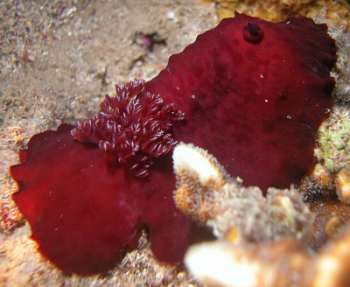
Dear Bill
During our night dive at the house reef of the Dive & Trek resort in Anilao, Philippines, we found this beautiful specimen. Further details are as follows:-
Size: 15 cm (size of a palm)
Date: 19 January 2004
Time: 7.15 pm
Depth: 5 metres
Temperature: 25 Celsius
The photo was taken by my trusty buddy, Mabel Fang.
We have not been able to match this find against any reference books and we hope that you can help us and at the same time to provide your site with a new record.
Looking forward to your feedback.
Kind regards
Philip Lau
phillau@singnet.com.sg
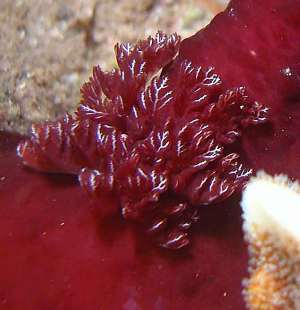
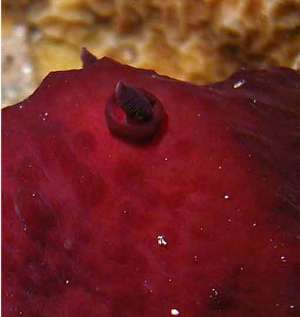
Dear Philip,
I have this species on the Forum as a possible 'form' of Asteronotus cespitosus but I have the feeling it has recently been named as a distinct species. If anyone can enlighten me I would be grateful. If you look through the other messages on this page you will find a few photos of it
Best wishes
Bill Rudman
Asteronotus cespitosus? from Solomon Ids
July 16, 2003
From: Bruce Potter
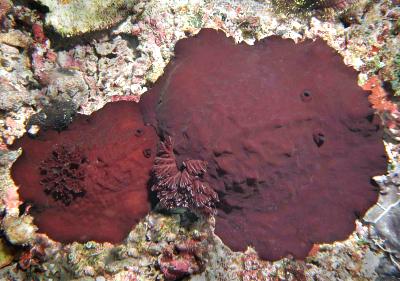
Dear Bill,
On a recent trip to the Florida Islands, in the Solomon Islands, I dived a site called "Velvia". I did 6 dives on the site in a couple of days. In that time I saw at least 6 different individual Asteronotus cespitosus of varying sizes, but all of this dark red colour. The largest was about 250mm, and the smallest about 120mm. The attached photo shows two of different sizes.
What interested me was that I did not see any of the more traditional colour form. If they are in fact the same animal, and there is a progression from the smaller ones with tubercules and colour patches, to larger and plain red or brown, why did I not see any of the patterned ones on the site? The smaller of the plain red ones I found, were similar in size to the other patterned ones I have found elsewhere.
The two in the photograph were at about 12 meters deep, and the larger of the two was about 250mm. Velvia is a sea mount covered in coral and rubble and lots of hard and soft corals and sponges and tunicates. This is the site we usually find the Nembrotha family on. We found N. kubaryana, N.cristata, and N. milleri
Regards,
Bruce Potter.
bruce.potter@adventist.org.sb
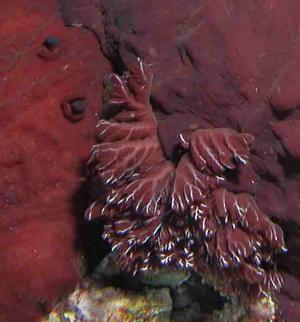
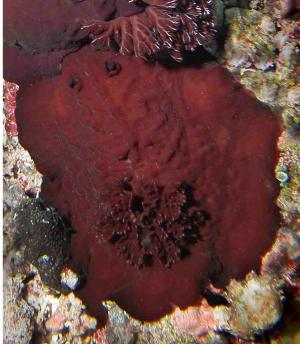
Thanks Bruce,
Any comments on whether this dark red brown animal is A. cespitosus is welcome. Certainly in external shape it looks very similar, but I don't know if anyone has seen a red-brown specimen with a colour pattern similar to that of the typical A. cespitosus. Bernard Picton, in an earlier message, considers that it is most probably a distinct species because of its consistent colour difference
Best wishes,
Bill Rudman
Asteronotus cespitosus?
November 16, 2002
From: Ginette Allard
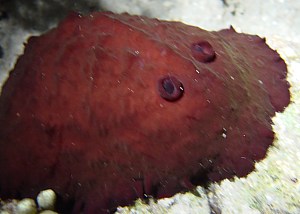
We send you a photo from a small island near Manado. The photographer is Annie Bigot. We took this photo when snorkeling at night (6pm) This "Pleurobranchus" was near the sea shore, 2 meters deep on a sandy flat place beetween a few stony corals. It seemed not to like our lights very much. Could you please identify it and send us your answer ?
Location: Siladen Island, near Manado, Indonesia. (at 6pm - night) near the sea
Size : 20cm
color : very dark red
Nothing special on the mantle except the 2 rhinophores (retracted on the photo). We are from France and we did a training session in Siladen in July 2002 (2 weeks). Could you please help us identify it?
Best wishes,
Ginette
gigiallard@aol.com
Allard, G., 2002 (Nov 16) Asteronotus cespitosus?. [Message in] Sea Slug Forum. Australian Museum, Sydney. Available from http://www.seaslugforum.net/find/8398Dear Ginette,
The rhinophores contracting into their own pockets is a sure sign this is a nudibranch not a pleurobranch, although Pleurobranchus forskalii and Pleurobranchus grandis can both have dark brown colour forms like this. In fact Bernard Picton, in an earlier message noted the similarity of this animal to a pleurobranch. At present I have this animal identified on the Forum as a colour form of Asteronotus cespitosus but I can't say I am 100% convinced. [See message 1, message 2].
Best wishes,
Bill Rudman
Asteronotus cespitosus from the Solomons
April 12, 2002
From: Bruce Potter
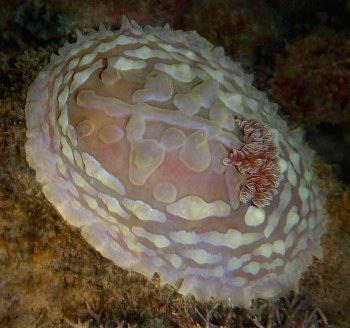
Dear Bill,
A year or two ago I discovered a giant red form of Asteronotus cespitosus, then in January of this year I found a different, pink and yellow form. Now I have found what I think of as a "typical" form. This was found on a coral and rubble site on the outskirts of Honiara, Solomon Islands.
It was about 150mm long and found at about 9 meters depth. This was quite near where I found the pink and yellow one in January.
Regards
Bruce Potter.
bruce.potter@adventist.org.sb
Potter, B., 2002 (Apr 12) Asteronotus cespitosus from the Solomons. [Message in] Sea Slug Forum. Australian Museum, Sydney. Available from http://www.seaslugforum.net/find/6717Dear Bruce,
This is certainly the 'real' Asteronotus cespitosus.
Bill Rudman
Asteronotus cespitosus from the Solomon Ids
January 19, 2002
From: Bruce Potter
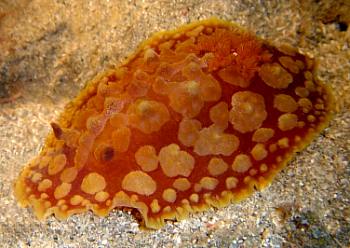
Dear Bill,
For only the second time I have found an Asteronotus cespitosus. The previous one was a giant at about 400mm, and was plain dark red. This one, which I found on a night dive on 16 Jan 2002, was about 150mm, and more like those I see in books. It was on a rubble site, just on the outskirts of Honiara, Solomon Islands, and at about 8 meters.
Underneath the rock it was on was a large coil of bright orange eggs, that obviously belonged to it. It also had a small shrimp hitching a ride, which is visible on one of the photos (lower left).
Regards
Bruce Potter.
bruce.potter@adventist.org.sb
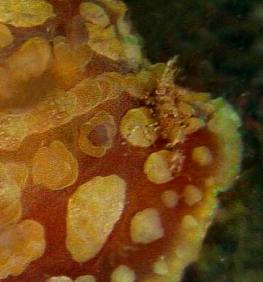
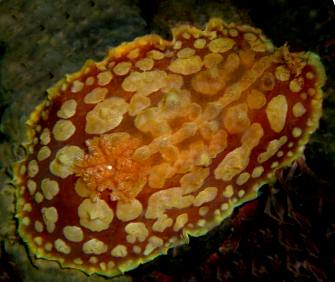
Dear Bruce,
Yes this certainly looks more like typical Asteronotus cespitosus. Its a bit hard to make out the detail of the little shrimp. It is possibly Periclimenes imperator, which is the shrimp ofte found associated with Hexabranchus and other large sea slugs.
Best wishes,
Bill Rudman
Re: Asteronotus variability
September 25, 2001
From: Julie Marshall
Dear Bill,
Most of the usual brown colour form of Asteronutus cespitosus which I have found at at Heron Island are around 120 to 160 mm in size. Some have been smaller but all have the same arrangement of pustules on the mantle. The dull yellow animal with the numerous pustules was only 90 mm so I don't think size is reason for the variation. Possibly it is a different species?
Best wishes,
Julie Marshall
juliemarshall@netspace.net.au
Marshall, J., 2001 (Sep 25) Re: Asteronotus variability. [Message in] Sea Slug Forum. Australian Museum, Sydney. Available from http://www.seaslugforum.net/find/5324Thanks Julie,
Yes it's certainly possible that there is more than one species of Asteronotus. Perhaps the uniformly coloured 'species' needs another name.
Cheers,
Bill Rudman
Re: Asteronotus variability
September 22, 2001
From: Julie Marshall
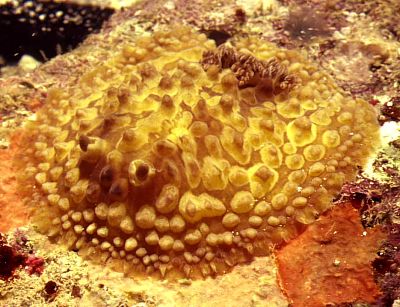
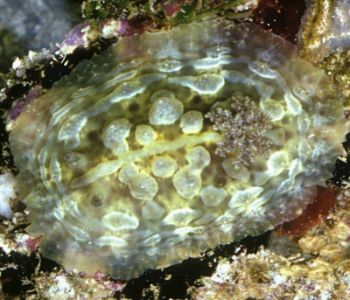
Dear Bill,
Following on from recent messages, here are pictures of some other variations of the usual brown Asteronotus cespitosus. Occasionally on Heron Island [Great Barrier Reef, Queensland] I find dull yellow and pale green animals at the reef crest. Whilst the pale green animal has the same arrangement of pustules as the usual brown, solid-looking animal, the dull yellow animal has far more numerous and isolated pustules on its mantle. The mantle of the pale green animal does differ in some respects from the usual brown animal in being less dense and almost transparent at its edge.
Best wishes,
Julie Marshall
juliemarshall@netspace.net.au
Thanks Julie,
Are these both quite large animals? I wonder whether the typical pattern breaks up when they reach a large size. I can't recall seeing small animals without the 'typical' colour pattern.
Cheers,
Bill Rudman
Re: Asteronotus from Solomon Ids
September 18, 2001
From: Bernard Picton
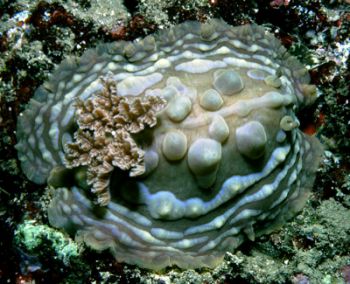
Hi Bill,
I saw an animal very like the one in Bruce Potter's message in Bali in 1996 at night. It was large, but about the same size as a typically coloured Asteronotus cespitosus, indeed I photographed a typical animal on the same dive [UPPER RIGHT]. I assumed, on the basis of the difference in pigmentation and height of the tubercles and ridges that the dark red animal was a separate species.
The dark red animal was pigmented like some species of Pleurobranchus which are also only seen out at night, the colour seems to absorb flashlight and is difficult to expose correctly, appearing almost black in the photographs [LOWER RIGHT]. It had a small shrimp associated with it [LOWER LEFT].
All FROM: Pemuteran, Bali, Indonesia. April 1996, 8-15m depth at night.
Bernard
bernard.picton.um@nics.gov.uk
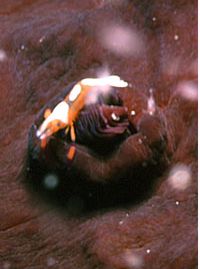
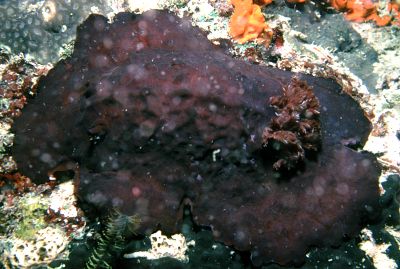
Thanks Bernard,
It could be a distinct species. It definitely needs someone to compare the anatomy of the dark 'form' and the more typical colour form.
Best wishes,
Bill Rudman
Asteronotus from the Solomon Ids
September 12, 2001
From: Bruce Potter
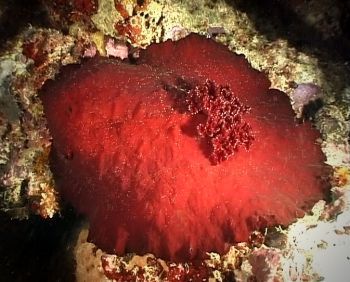
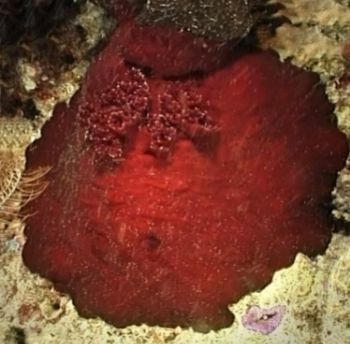
Dear Bill,
I found this huge specimen last weekend. The dive site was "Wreck of the Anne" in the Russell Islands Group of the Solomon Islands.
It was on a night dive, and the critter was at about 8 meters on coral and rubble. It was about 40 cm long. The largest nudibranch I have ever seen. I am guessing it is some kind of Asteronotus.
Regards
Bruce Potter.
bruce.potter@adventist.org.sb
Potter, B., 2001 (Sep 12) Asteronotus from the Solomon Ids. [Message in] Sea Slug Forum. Australian Museum, Sydney. Available from http://www.seaslugforum.net/find/5254Thanks Bruce,
The general belief is that there is only one species of Asteronotus. In all the records I know of of very large animals, the colour is usually a shade of brown, suggesting perhaps that they lose the colour pattern of light and dark regions as they grow older and larger. See Erwin Koehler's earlier message for another photo of a uniform brown animal. See the 'Largest, smallest etc Page' for more messages on large sea slugs. 40 cm is a good size.
Best wishes,
Bill Rudman
Asteronotus? from PNG
May 20, 2001
From: Erwin Koehler
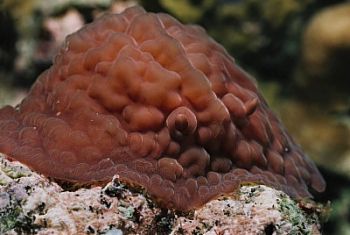
Dear Bill
Attached is a photo from Papua New Guinea made by Beate and Peter Lange
Email: beate.lange@aon.at
Other data were not recorded. Is it a species of Asteronotus or something else?
Erwin
Erwin@medslugs.de
Koehler. E., 2001 (May 20) Asteronotus? from PNG. [Message in] Sea Slug Forum. Australian Museum, Sydney. Available from http://www.seaslugforum.net/find/4055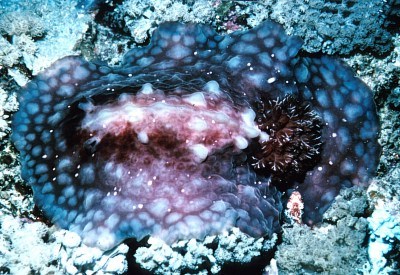
Dear Erwin,
Yes it is Asteronotus cespitosus, another common species which has not appeared on the Forum until now. It has quite a range in colour, sometimes being a uniform brown or khaki colour. I have attached a photo alongside of an animal from W of Bonege Island, Guadalcanal, Solomon Ids, 10 October 1983. Photo: I Knight
Best wishes,
Bill Rudman
Asteronotus cespitosus from the Philippines
May 20, 2001
From: Mary Jane Adams
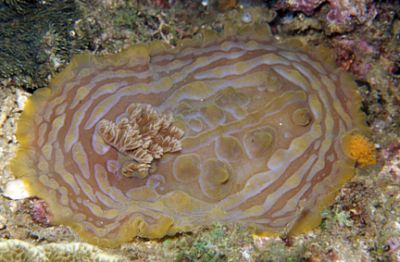
Hi Bill,
I recently had the privilege of accompanying Terry Gosliner and some of his grad students and associates on a collecting trip to the Philippines. During 21 dives in Batangas the team found 205 different opisthobranch species. I found this Asteronotus cespitosus crawling across the reef on a night dive. Depth: 12 meters, Length: about 20 cm
Best regards,
Mary Jane
divepng@yahoo.com
Adams, M.J., 2001 (May 20) Asteronotus cespitosus from the Philippines. [Message in] Sea Slug Forum. Australian Museum, Sydney. Available from http://www.seaslugforum.net/find/4379Dear Mary Jane,
It sounds as though the opisthobranchs kept you all busy. It sounds as though you had a productive trip. Your photo of Asteronotus arrived just as I was about to post a message from Erwin Koehler of a rather dull-coloured specimen from Papua New Guinea and another from the Solomon Ids, so I have posted yours as well.
Cheers,
Bill Rudman
